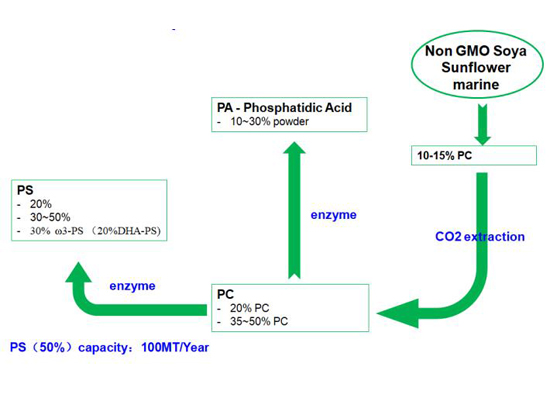sdfsd
Phosphatidylserine
|
Technical Data Sheet
Net weight: 25kgs/Drum Gross weight: 27.5Kgs±0.5kg/Drum. Packing size: Drum.I.D.35×H45cm 24 months under in a well-closed container and away from moisture, light, oxygen. Packed in paper-drums or carton with two plastic-bags inside. |
Phosphatidylserine(Soybean) FLOW CHART
|
Phosphatidylserine
Phosphatidylserine is a chemical that is important for many functions in the human body, especially in the brain. Small amounts are found in most foods.
Phosphatidylserine is part of the cell structure in the body. The body can make phosphatidylserine, but most of what it needs comes from foods. It can also be taken as a supplement. These supplements were once made from cow brain. Now they are commonly made from cabbage or soy.
Phosphatidylserine is used for Alzheimer disease and normal age-related decline in memory and thinking skills. It is also used for athletic performance, ADHD, and many other purposes, but there is no good scientific evidence to support most of these uses.
How does it work ?
Uses & Effectiveness
Possibly Effective for
Decline in memory and thinking skills that occurs normally with age. Taking phosphatidylserine that is made from cow brain by mouth seems to improve attention, language skills, and memory in aging people with declining thinking skills. But most phosphatidylserine supplements are now made from soy or cabbage. It's not clear if these supplements have the same effects.
Alzheimer disease. Taking phosphatidylserine that is made from cow brain by mouth can improve some of the symptoms of Alzheimer disease after 6-12 weeks of treatment. But it might become less effective over time. Most phosphatidylserine supplements are now made from soy or cabbage. It's not clear if these supplements have the same effects.
There is interest in using phosphatidylserine for a number of other purposes, but there isn't enough reliable information to say whether it might be helpful.
Side Effects
When taken by mouth: Phosphatidylserine is possibly safe when used for up to 3 months. Phosphatidylserine can cause side effects such as insomnia and stomach upset, especially at doses over 300 mg.
There's some concern that products made from animal sources can transmit diseases, such as mad cow disease. To date, there aren't any cases of humans getting animal diseases from phosphatidylserine supplements. But stay on the safe side and look for supplements made from plants.
Special Precautions and Warnings
Pregnancy and breast-feeding: There isn't enough reliable information to know if phosphatidylserine is safe to use when pregnant or breast feeding. Stay on the safe side and avoid use.
Children: Phosphatidylserine is possibly safe when taken by mouth for up to 4 months in children 4-18 years of age.
Interactions
Moderate Interaction
Be cautious with this combination
Drying medications (Anticholinergic drugs) interacts with PHOSPHATIDYLSERINE
Phosphatidylserine can increase a chemical in the body called acetylcholine. Acetylcholine plays a big part in many important body functions. Some medications, called anticholinergic drugs, block the effects of acetylcholine in the body. Taking phosphatidylserine might decrease the effects of anticholinergic drugs.
Various medications used for glaucoma, Alzheimer disease, and other conditions (Cholinergic drugs) interacts with PHOSPHATIDYLSERINE
Phosphatidylserine can increase a chemical in the body called acetylcholine. Some medications that are used for glaucoma, Alzheimer disease, and other conditions, also increase acetylcholine levels. Taking phosphatidylserine with these medications might increase the chance of side effects.
Dosing
Phosphatidylserine has most often been used by adults in doses of 200-400 mg by mouth daily, for 1-3 months. Speak with a healthcare provider to find out what dose might be best for a specific condition.
Most phosphatidylserine supplements used to be made from cow brain. This raised concerns about transmitting animal disease, such as mad cow disease, to humans. There aren't any cases of this happening, but most products now come from soy and cabbage. Stay on the safe side and stick with these plant-based products.
from:https://www.webmd.com/vitamins/ai/ingredientmono-992/phosphatidylserine
CONTACT US
Add:4A-Buliding A3, 2nd Liheng Industrial Park,Fanhuan Road,Hefei 230092,China
TEL: (+86) 551 62828690
Fax: (+86) 551 62828697
Email: sales@health-sources.com
Copyright © HEALTH SOURCES NUTRITION CO., LTD.
Our website contains material and information intended for B2B customers, suppliers and distributors, and is not intended as information to the final consumers. The statements on this website have not been evaluated by the Food and Drug Administration. This product is not intended to diagnose, treat, cure or prevent any disease. In developing claims for a food, beverage or supplement product label, manufactures should seek guidance to assure compliance with the appropriate regulatory authority.





